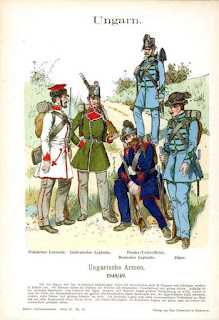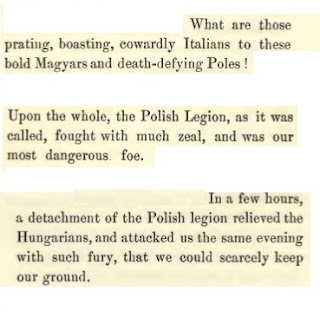My Newest Addition: Fireforge Mongol Camel Drummer and Tsubodai
And now, for something completely different...SAGA fever has caught on in my gaming circle. Originally, I was simply a mildly interested bystander to these SAGA goings on. Upon further investigation, though, I realized that the low SAGA figure count meant that I had among my Smalle Warre Tartar contingent more than enough figs to represent a 6 point Mongol Saga Warband. So, with no investment in new figures or painting time, it was an easy leap to give SAGA a try--and with the dreaded Mongols, no less. Given that our club will be having a SAGA Game Day in October, I decided that I should upgrade my Mongol specialty figures, namely the Warlord and Mongol Camel Drummer. Hence this post. After casting about for options, I settled on Fireforge figures.
Heavy Metal: Fender Washers for Heft
MONGOL CAMEL DRUMMER
Although I used the Fireforge model as an example, I did other research and reinterpreted the figure in my own way. To keep him from looking like he was wearing a giant pancake on his head, I painted the fur lining of the Mongol cap, even though this detail is not in the sculpt. This was also my first attempt at rendering chain mail: I'm tempted to try a few other medievals based on the result. Here are a few more angles:
To seat the rider, I found that I had to bend the scabbard to the point where it cracked in order to get it around the two bags to the rider's left rear.
TSUBODAI
The confluence of plastic where the reins met on the horse's mane was quite wide. Given the rider's hand position, I needed to trim this in order to seat the figure. Fortunately, this was quite easy to do and didn't impact the look or lines of the figure.
The figs as seen more from tabletop distance.
PAINTING GUIDE:
GENERAL NOTES All colors are flat or matte (except for MM Gold).
All paints are Enamels: Humbrols, Testors Model Master (abbreviated "MM" below), and Testors ¼ ounce bottles (abbreviated "Testors").
Black Wash: Vallejo Black Wash (Dipping Formula Immersion)—used as wash, not dipped.
Black Wash Technique: Black wash (thin or regular), then gone over again in either the original color to highlight and clean up the "dirty" look left behind by the wash or a lighter color to add effects. For brevity, if the description just says “black wash," then it was also highlighted in the original color.
PRIMER: I primed the figures in white (I'm a white primer guy).
BOTH RIDERS
Face & Hands: Humbrol 61 Matt Flesh with thin Black Wash
Eyes: MM Light Gray
CAMEL DRUMMER
CAMEL Camel Torso: Base: MM Military Brown Black Washed then Highlighted with MM Dark Tan Camel Cords: Underpainted Black then painted with Humbrol 62 Leather
Camel Bit: Underpainted Black then painted with Testors Flat Steel
Saddle Blanket: Humbrol 80 Grass Green then then Black Wash
Saddle Pad: MM Leather
Leather Pouches: MM Leather then Black Washed
Other Bags: MM Flat Light Gray then Black Washed and Highlighted MM Flat White
Rolled thingy: MM Dark Tan with Black Straps then Black Washed
Drums: Humbrol 100 Red Brown with thin Black Wash
Drum Heads: Humbrol 103 Cream with thin Black Wash, Highlighted with MM Light Gray
Drum Cords: Underpainted black then painted MM Light Gray—brushed with MM Flat White
RIDER
Sleeves: Humbrol 74 Linen Yellow then thin Black Wash & Highlighted with Humbrol 81 Pale Yellow
Chainmail: Underpainted Flat Black then brushed with Testors Flat Steel
Felt Coat (small bit showing between chainmail and sleeves): Humbrol 113 Rust
Trousers: Humbrol 157 Matte Azure Blue Highlighted with Humbrol 89 Middle Blue
Boots: Humbrol 62 Matt Leather Black Washed
Hat and Earflaps: Humbrol 62 Matt Leather Black Washed
Hat Lining: MM Light Gray, Black Washed, Highlighted with MM Sea Gray & Dappled with MM Flat White.
Drumsticks: MM Italian Dark Brown
Scabbard: MM Leather
Scabbard Ornaments: Testors Flat Brass Highlighted with MM Gold and Outlined in Flat Black.
Sword handle: Black grip with knob in Testors Flat Brass Highlighted with MM Gold
TSUBODAI
HORSELegs & Head: Underpainted MM Burnt Umber then Brushed with MM Burnt Sienna
Tail and Mane: Flat Black Brushed with MM Gunship Gray
Blanket (showing under armor): MM Sand, Black Washed and Highlighted with Humbrol 81 Pale Yellow
Scale Armor: Underpainted Black then brushed with alternating lines of Testors Flat Steel and Testor’s Flat Brass, the latter highlighted with a light brush of MM Gold.
Head Armor: Testors Flat Brass brushed with MM Gold.
Head Ornament: Underpainted black then Brushed with Testors Flat Brass and Highlighted with MM Gold. Black lined at joint of face armor.
Armor Edging: MM Insignia Red Brushed over with Testors Flat Red
Harness: Humbrol 62 Matt Leather
Reins: MM Leather
Saddle Rear: MM Natural Wood & Humbrol 113 Rust--edged with Testors Flat Brass.
Saddle Front: Humbrol 113 Rust.
Whatsit? Cylinder on Right Side: MM Leather with Testors Flat Brass Brushed with MM Gold, outlined in flat black.
Quiver: MM Leather with ornaments in Testors Flat Steel outlined in flat black.
Arrows: Underpainted Flat Black then brushed with MM Light Gray and Highlighted with MM Flat White
RIDER
Scale Armor, and Helmet: Underpainted black then brushed with Testors Flat Steel
Horsehair Plume: Flat Black Highlighted with MM Gunship Gray
Armor Edge (Lower Front and Bottom): Underpainted black then in Testors Flat Brass Highlighted with MM Gold
Inlays on Shoulder Scales, Helmet Spike, Visor & Edges: Underpainted black then Testors Flat Brass Highlighted with MM Gold.
Chest Straps: Humbrol 62 Leather
Arm Hole Lining : MM Leather
Scabbard and Bow Holster: MM Leather with Testors Flat Brass Highlighted with MM Gold ornaments underpainted/outined in Flat Black
Bow: MM Natural Wood; Tip in Testors Flat Brass Highlighted with Testor’s Gold;
Bow Inlays and Ornaments: Black Bands with Testor’s Flat Brass Highlighted with MM Gold.
Undercoat: MM Bright Blue with thin Black Wash & Highlighted with Humbrol 89 Middle Blue Trousers: Humbrol 80 Grass Green with thin Black Wash
Boots: Humbrol 62 Leather Black Washed
Sash: MM Insignia Red Brushed with Testors Flat Red
Belt: Humbrol 62 Leather. Buckle underpainted Flat Black & then Testors Flat Brass touched with MM Gold.
Stirrups: Testors Flat Steel
Sword: Blade, Testors Flat Steel; Guard, Testor’s Flat Brass brushed with MM Gold. Black Washed.
Sword Lanyard: Testor’s Flat Red
Excelsior!
















